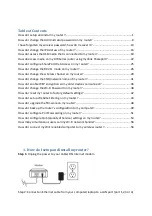
PROLiNK
®
PWH2004 User Manual
www.prolink2u.com
Revision 1.0 (Aug’09)
51
APPENDIX B – ABOUT WIRELESS LAN
B.1 BBS
A group of Wireless Stations and a single Access Point, all using the same ID (SSID), form a Basic Service
Set (BSS).
Using the same SSID is essential. Devices with different SSIDs are unable to communicate with each other.
B.2 Channels
The Wireless Channel sets the radio frequency used for communication.
•
Access Points use a fixed Channel. You can select the Channel used. This allows you to choose a
Channel which provides the least interference and best performance. In the USA and Canada, 11
channels are available. If using multiple Access Points, it is better if adjacent Access Points use
different Channels to reduce interference.
•
In "Infrastructure" mode, Wireless Stations normally scan all Channels, looking for an Access Point.
If more than one Access Point can be used, the one with the strongest signal is used. (This can
only happen within an ESS.)
Note
to US model owner: To comply with US FCC regulation, the country selection function has been
completely removed from all US models. The above function is for non-US models only.
B.3 Security
B3.1 WEP
WEP (Wired Equivalent Privacy) is a standard for encrypting data before it is transmitted. This is
desirable because it is impossible to prevent snoopers from receiving any data which is transmitted
by your Wireless Stations. But if the data is encrypted, then it is meaningless unless the receiver
can decrypt it.
If WEP is used, the Wireless Stations and the Access Point must have the same security settings
for each of the following:
WEP
64 Bits, 128 Bits.
Key
For 64 Bits encryption, the Key value must match.
For 128 Bits encryption, the Key value must match.
WEP Authentication
Open System or Shared Key.





































